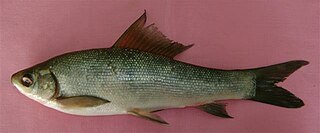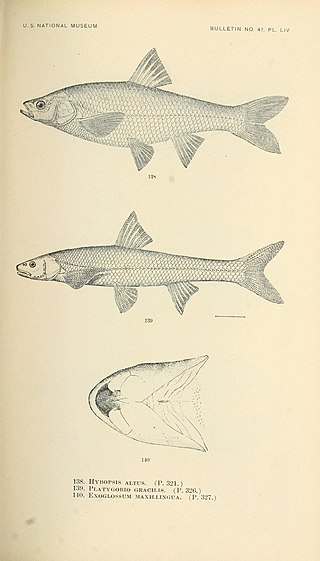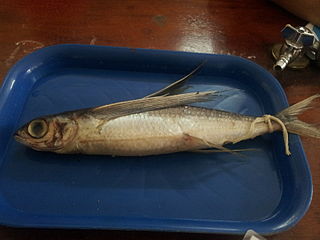
The black ruby barb or purplehead barb is a tropical cyprinid fish endemic to Sri Lanka, where it occurs in forested streams from the Kelani basin to the Nilwala basin. They are found in streams on hills around 1000 ft in elevation. The brightly colored population introduced to Mahaweli at Ginigathena, Sri Lanka, is said to have diminished in number due to the aquarium export trade.

The common dace is a species of freshwater and brackish water ray-finned fish from the family Cyprinidae which is native to Europe but which has been introduced to other parts of the world. It is a quarry species for coarse anglers.

The Arulius barb is a tropical cyprinid fish native to the Kaveri River basin of south east India. Other common names include Tamiraparani barb, Silas barb and longfin barb.
Labeo lankae is a species of cyprinid fish. It is endemic to Sri Lanka.
The ningu is a species of ray-finned fish in the family Cyprinidae. It is found in the Lake Victoria basin in Burundi, Kenya, Tanzania, and Uganda. Its natural habitats are rivers, swamps, freshwater lakes, freshwater marshes, and inland deltas. It is threatened by a loss of habitat due to pollution, siltation and drainage as agriculture expands in the Lake Victoria basin, by overfishing on their breeding migrations and by introduced alien fish.
The lake salmon or mpasa is an African species of freshwater fish, endemic to Lake Malawi, in the family Cyprinidae found in Malawi, Mozambique, and Tanzania. Its natural habitats are rivers and freshwater lakes.
The Wilpita rasbora is a species of ray-finned fish in the family Cyprinidae. It is found only in Wilpita, Sri Lanka where it occurs in heavily shaded shallow, sluggish, streams.
The Sandhills chub is a species of freshwater fish in the family Cyprinidae of order Cypriniformes. There are 4 species of Semotilus, 2 of which occur in South Carolina. This fish is found only in North Carolina and South Carolina. The Sandhills chub is predominately found in the Carolina Sandhills and some areas of Cape Fear, Pee Dee and Santee river drainages. It is characterized by its robust body, large head and lack of a dark blotch or smudge on their dorsal fin which is present on the closely related Creek Chub. The Sandhills chub has fine scales, a pinkish body and can be up to 9.4 inches.
Sicyopterus lagocephalus, the red-tailed goby or blue stream goby, is a species of goby native to islands of the Indian Ocean from the Comoros to the Mascarene Islands to the Pacific Ocean where it reaches French Polynesia and can be found as far north as Japan. It is an amphidromous species: adults can be found in swift-flowing streams with rocky beds but the eggs hatch at sea and the larval stage remains in marine waters, migrating to freshwaters when they reach the postlarval stage. This species can reach a total length of 13 cm (5 in). In some places it is an important species for local consumption with the post-larvae being caught as they mass in estuaries.

The Kuria labeo is a species of fish in the carp family, Cyprinidae. It is native to Pakistan, India, Bangladesh, and Burma, and it is known from Afghanistan and Nepal.

The doubleband surgeonfish or lieutenant tang, is a marine ray-finned fish in the family Acanthuridae. It is found in the tropical and sub-tropical Indo-Pacific region and grows to a maximum length of 31 cm (12 in).
Pethia cumingii, known as the Cuming's barb or the two spot barb, is a species of cyprinid fish endemic to Sri Lanka.

Labeo dussumieri is fish in genus Labeo known to occur in west-flowing rivers of the Western Ghats. Earlier Sri Lankan population was considered as the same species as L. dussumieri, recent phylogenetic and physiological differences suggest that Sri Lankan population is a distinct species, Labeo heladiva..
The harlequin sharkminnow is a freshwater cyprinid fish from central Africa. It is also known as the harlequin shark and variegated shark, especially in the aquarium hobby.

Garra ceylonensis is a species of ray-finned fish in the cyprinid family. It is endemic to rivers and streams in Sri Lanka - and is considered as a schooling fish. It is a rheophilic species and occurs in slow to moderately flowing rivers and streams, and ascends small, rocky streams in order to breed. It primarily feeds on algae such as diatoms.

The flathead chub is a species of fish in the carp family, Cyprinidae. It is the only member of the monotypic genus Platygobio. It is native to North America, where it is distributed throughout central Canada and the central United States.

The horadandia, green carplet, or glowlight carplet, is a species of very small cyprinid fish that is found in slow-moving or still fresh and brackish water habitats in western Sri Lanka. Earlier thought to be a monotypic genus with the single species found in both Sri Lanka and India, an analysis published in 2013 showed that the Indian population should be recognized as a separate species, Horadandia brittani.

Siganus insomnis, the bronze-lined spinefoot, is a species of marine ray-finned fish, a rabbitfish belonging to the family Siganidae. It is found in the northern central Indian Ocean. It had formerly been confused with S. lineatus, but was recognized as a separate species in 2014.

Lutjanus lemniscatus, the yellowstreaked snapper, darktail snapper, darktail seaperch or maroon sea-perch is a species of marine ray-finned fish, a snapper belonging to the family Lutjanidae. It is native to the western Pacific and Indian Oceans.

Cheilopogon nigricans, the blacksail flyingfish, also known as African flyingfish, or leaping flyingfish, is a flying fish in the family Exocoetidae. It is an oceanodromous, plankton-eating marine fish which has commercial value.













